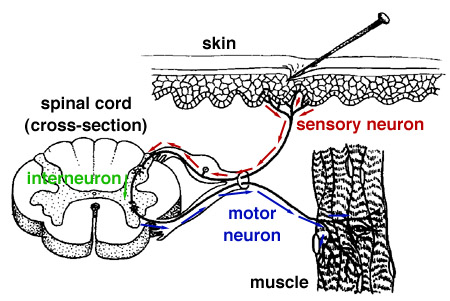BIOL 1400 -- Lecture Outline 37
"The question of whether a computer can think is no more interesting than the
question of whether a submarine can swim." -- E. W. Dijkstra
I. Synapses
- What happens when the action potential reaches the end of the neuron?
- The point where an axon of one neuron and a dendrite of another neuron meet
is called a synapse.
- The two neurons don't actually touch at the synapse. There's a minuscule gap
in between the two neurons.
- Inside the tip of a neuron's axon are a great many vesicles. Each is filled
with small molecules called neurotransmitters.
- When an action potential hits the end of an axon, the vesicles break open into the
synapse, and the neurotransmitter molecules spill out into the synapse.
- The neurotransmitters bind to receptor proteins on the other side of the synapse.
This stimulates an action potential to start moving down the second neuron.

Cross-section through a synapse. You can see the vesicles breaking open
at the cell membrane, releasing their contents.
- When neurotransmitters have been released into the synapse and have done their
job, they are either broken down by special enzymes in the synapse, or taken back
into the cell that they came from.
- If neurotransmitters weren't broken down or taken up, they would continue to
stimulate the "downstream" neuron over and over.
- Many drugs, legal and otherwise, work by blocking this re-uptake of neurotransmitters.
EXAMPLES:
- Prozac blocks the re-uptake of the brain neurotransmitter serotonin.
- Cocaine blocks the re-uptake of the brain neurotransmitter dopamine.
- Sarin (nerve gas) blocks the re-uptake of the transmitter acetylcholine
(which is used by the nerves that stimulate muscles to contract).
- Other drugs, legal and otherwise, work by mimicking a neurotransmitter.
- LSD mimics the brain neurotransmitter serotonin.
- Psilocybin (the active ingredient in "shrooms") and mescaline (the
active ingredient in peyote cactus) mimic the brain neurotransmitters dopamine
and/or noradrenaline.
II. How do neurons work together?
- A simple neuron circuit
- When you touch a hot stove or a sharp object by mistake, you pull your hand away
even before your brain is aware that you've done it. This is a reflex, and
it's done by means of a loop of only three nerves, a reflex arc.
- Sensory nerves in your skin send action potentials down their axons when
stimulated by a particular stimulus (different nerves fire for different stimuli,
such as cold, heat, pain, and pressure)
- The axon of a sensory nerve runs all the way to the spinal cord, a
finger-thick cord of neurons running to and from the brain. . .
- . . . and the sensory nerve axon forms a synapse with a short interneuron,
which is thus stimulated to fire an action potential. . .
- . . . to a motor neuron, which sends an action potential down its length
back to the same place where the sensory nerve was stimulated first.
- The motor neuron's action potential causes muscles to contract.
- Notice that the brain was not involved at all. Reflexes like this should work even
for someone in a coma, with severe brain damage, or with no brain at all.

Diagram of a simple reflex arc
- Neural processing
- BIG QUESTION: How do neurons generate complex behaviors -- like coordinated
movement, complex sensory perceptions, and even thought?
- One neuron may receive input from hundreds or thousands of other neurons.
- Conversely, one neuron may send axon branches to hundreds or thousands of other
neurons.
- We've already talked about how a signal is carried across a synapse. . .
- What I described is an excitatory synapse -- one neuron firing
stimulates another neuron to fire.
- There's another type of connection, an inhibitory synapse -- one
neuron firing causes another neuron not to fire.
- One neuron may have many connections with others -- both excitatory
and inhibitory. Whether that neuron fires or not depends on the sum total
of all the inputs it gets.
- This enables neurons to act much like computer logic circuits.
- (Computer science majors will recognize this: Neurons acting together form
Boolean AND gates, OR gates, NOT gates, XAND, XOR, and so on. Everyone else: don't
worry about this!)
- "Simple" example: visual edge processing (discussed in lecture).
Go to Previous Notes |
Return to Lecture Schedule |
Return to Syllabus |
Contact the Prof |
Go to Next Notes

